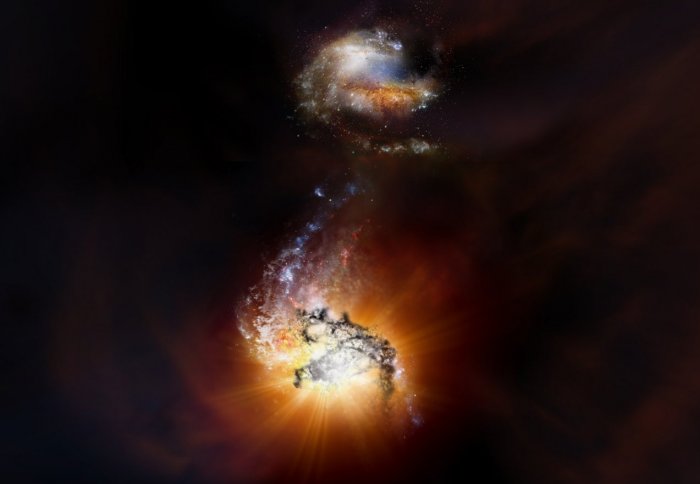
A pair of exceptionally rare hyper-luminous star-forming galaxies have been discovered, representing an extreme galaxy merger.
The two extremely bright and massive galaxies have been caught in the act of merging in the early universe. These so-called hyper-luminous starburst galaxies are exceedingly rare at this epoch; as a pair, they may represent one of the most-extreme examples of violent star formation ever observed.
Astronomers speculate that this merger may eventually form the core of an entire galaxy cluster, which are among the most massive structures in the universe.
The galaxies were spotted by ESA’s Herschel Space Observatory (HSO) telescope, and then further analysed by the Atacama Pathfinder Experiment(APEX) telescope and the Atacama Large Millimeter/submillimeter Array(ALMA). The research team, which include Imperial College London physicists, published their discovery today in the Astrophysical Journal.
Co-author Dr Dave Clements, from the Department of Physics at Imperial, said: “This is a truly spectacular system, and one that could not be found by Hubble or even the largest optical telescopes on the ground.”
Extreme star-forming power
The two galaxies, named the horse and the dragon, or collectively the ADFS-27 system, are located approximately 12.7 billion light years from Earth in the direction of the Dorado constellation. At this distance, astronomers are viewing this system as it appeared when the universe was only about one billion years old.
The pairing of otherwise phenomenally rare galaxies suggests that they reside within a particularly dense region of the universe at this period in its history.
The new ALMA observations also indicate that, collectively, the ADFS-27 system has approximately 50 times the amount of star-forming gas as the Milky Way.
Dr Dominik Riechers, an astronomer at Cornell University and lead author on the paper said: “Much of this gas will be converted into new stars very quickly. Our current observations indicate that these two galaxies are indeed producing stars at a breakneck pace, about one thousand times faster than our home galaxy.”
The galaxies are brimming with extremely bright and massive blue stars. Most of this intense starlight, however, never makes it out of the galaxies themselves; there is too much obscuring interstellar dust in each.
As this dust absorbs the brilliant starlight, however, it heats up and glows brightly, reradiating that energy as intense light beyond the visible range.
ALMA was designed specifically to detect and study light of this nature, which enabled the astronomers to resolve the source of the light into two distinct objects.The observations also show basic structures of the galaxies, revealing tail-like features that were spun-off during the galaxies’ initial encounter.
Massiver merger
The new observations also indicate that the two galaxies are separated by about 30,000 light years and are currently moving at roughly several hundred kilometres per second relative to each other.
Eventually, each galaxy will slow and fall toward the other, likely leading to several more close encounters until they merge into one massive, elliptical galaxy. The astronomers expect this process to take a few hundred million years.
Dr Clements said: “This discovery emphasises the huge legacy left by the Herschel mission, even though it ceased operations four years ago. There will be many more exciting discoveries as we delve deeper into the Herschel archive.”
Dr Riechers added: “Eventually, we hope to combine the exquisite ALMA data with future infrared observations from NASA’s James Webb Space Telescope. These two telescopes will form an astronomer’s ‘dream team’ to better understand the nature of this and other such exceptionally rare, extreme systems.”













